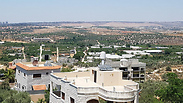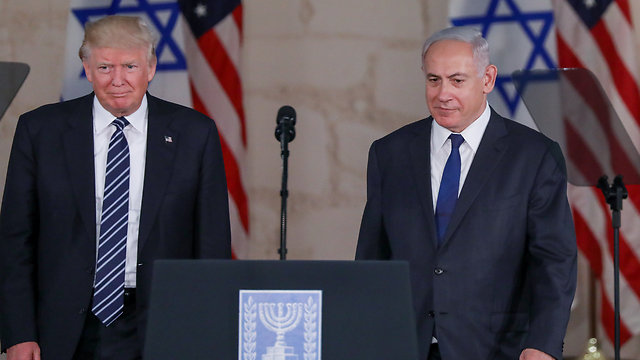

Netanyahu’s empty real estate gestures
Op-ed: In English, behind closed doors, the prime minister promises the world; in Hebrew, in front of the cameras, he holds on to every lump of earth. This game is being played even more intensely as he deals with the Trump administration’s expectations on the one hand, and with the ultra-rightist ministers in his government on the other hand.
In 2014, when the previous Netanyahu government was negotiating with the Palestinian Authority, the Israeli delegation presented a proposal to allot 30,000 or 35,000 dunams in the Palestinian cities’ suburbs for the purpose of building residential neighborhoods for the local population. The lands belonged to Area C, which is under full Israeli security control, and are inside the IDF fence surrounding the city.
It’s an old plan. They began working on it about six years ago, in light of the congestion in West Bank cities and the needs of negotiations. The 2014 version was formulated by the IDF, in the Civil Administration, in accordance with the political echelon’s instructions. Prime Minister Benjamin Netanyahu and then-Defense Minister Moshe Ya’alon were aware of the plan and approved it. Netanyahu, however, has his own method that serves him in every issue on the agenda: He supports a move with his left hand and disassociates himself from it with his right hand, or the other way around—he disassociates himself with his left hand and supports with his right hand.
In that negotiation, former minister Tzipi Livni was the left hand and attorney Isaac Molho was the right hand. Livni’s job was to advance the negotiations; Molho’s job was to play for time. Netanyahu held both positions simultaneously. He approved the proposal in principle, but not concretely. In other words, Livni was given the green light while Molho was given the red light. They clashed when Livni started discussing numbers.

American special envoy Martin Indyk knew about the proposal. It was first and foremost intended for him—to prove to the Obama administration that Netanyahu is willing to concede lands again. This is another area Netanyahu is consistent in: In English, behind closed doors, he promises the world; in Hebrew, in front of the cameras, he holds on to every lump of earth. This was the game he played then, and it’s even more intense now, as he deals with the Trump administration’s expectations on the one hand, and with the ultra-rightist ministers in his government on the other hand. When the trick succeeds, he was the first to identify; when the trick meets resistance, he was the first to forget.
That plan ended with nothing, because of the Palestinians. Mahmoud Abbas reached an agreement with Hamas. The agreement died shortly after it was born, but it killed the negotiations on the way. When we asked the prime minister’s spokespeople about it last week, they blamed Livni.
Ministers vs. IDF
The need for gestures to impress the Americans was raised again ahead of Jared Kushner and Jason Greenblatt’s return visit to Israel. Kushner, US President Donald Trump’s son-in-law, and Greenblatt, his special envoy, are real estate people. So is Trump, of course. Real estate will impress them. The IDF was asked to come up with a real estate gesture. Like other gestures, it was supposed to disappear before it ever has a chance to take off the ground.
The chosen city was Qalqilya. Its advantage is that there is a large land reserve within the fence surrounding the city—lands belonging to Palestinian owners. The disadvantage is the proximity to Israeli communities. People settled in Tzofim so they could live five minutes away from Kfar Saba and pay less. No one told them they were living two minutes away from Qalqilya. At the moment, there are 1,000 housing units in the area. According to Civil Administration estimates, by 2035—18 years from now—it will be possible to build 5,000 more apartments there, assuming the plan is implemented.
Trump will be thrilled, and by the time he understands what’s going on, the gesture will fade away.
Samaria Regional Council head Yossi Dagan immediately cried out. Dagan has strongholds in the Likud and Bayit Yehudi parties. The ministers panicked, causing Netanyahu to panic too: He recalled approving something for Qalqilya, but without numbers. His associates explained it wasn’t him—it was the IDF.

A campaign was immediately launched against the treacherous IDF. The participants were Ministers Ze’ev Elkin, Uri Ariel and Miri Regev and Knesset Member Moti Yogev. Jordan Valley Regional Council head David Alhaini accused the IDF of attempting a military coup, no less. “Senior” ministers, meaning one junior minister who was afraid to state his name, told right-wing journals that “the IDF misled the cabinet.”
The ministers directed their attacks at one military official—Maj. Gen. Yoav Mordechai, the coordinator of the government’s activities in the territories (COGAT). For three years now, Mordechai has been serving as Israel’s bridge to the Palestinian leadership, to the donor states and to the Arab world. He is the little boy who is sticking his finger in the hole that the government ministers, including Netanyahu, are drilling in the dike on a daily basis. Whoever thinks an IDF general can offer lands to anyone without the political echelon’s approval is living in Neverland, not in the State of Israel.
One of the protestors was Minister Elkin, a member of the Security Cabinet. He was abroad when the decision was made. On June 15, he sent a letter to Netanyahu and Defense Minister Avigdor Lieberman. “Advancing the plan is, in my opinion, an attempt by the IDF’s top echelon to shape a new reality behind the political echelon’s back,” he wrote.
Where Elkin came from, the Soviet Union, such a letter would lead to a staged trial, and then an execution by a firing squad, guilty or not guilty. I told him that a few days ago. He said I was exaggerating.
The answer arrived from the defense minister. “Attack me,” Lieberman suggested, taking full responsibility for the Qalqilya gesture. Elkin, I must say, rushed to apologize to Mordechai on the radio, but his opinion hasn’t changed. “I called the two closest people to Netanyahu and Lieberman,” he told me. “They both gave me the same answer: When the report was published, they asked their assistants to check its source. Both Bibi and Yvette didn’t know.”
Elkin knows there is nothing new in the plan. It’s the procedure that bothers him. “The question is to what extent can the cabinet be fooled,” he said. He claims that the meeting's minutes reveal the ministers were lied to. They were told that the plan was to whitewash existing construction, not new construction.
Who lied, I asked.
“I don’t know,” he said. “I wasn’t there.”
You’re acting all innocent, I said. You’re attacking Mordechai and Lieberman because you’re afraid to directly attack Netanyahu.
Elkin wasn’t offended. “It’s clear Netanyahu knew,” he said calmly, “but he was probably not too interested.”
With all due respect to the procedure, what troubles him and his friends is who will sit on the piece of real estate known as Area C. In his letter, he complains that the Palestinians are about to get an approval to build, while the settlers are hardly getting any permits. The Palestinians are receiving benefits; the settlers are being deprived. “This is a reality of serious discrimination against the needs of the Israeli settlement in Judea and Samaria,” he writes.
George Orwell wouldn’t have said it better.
















